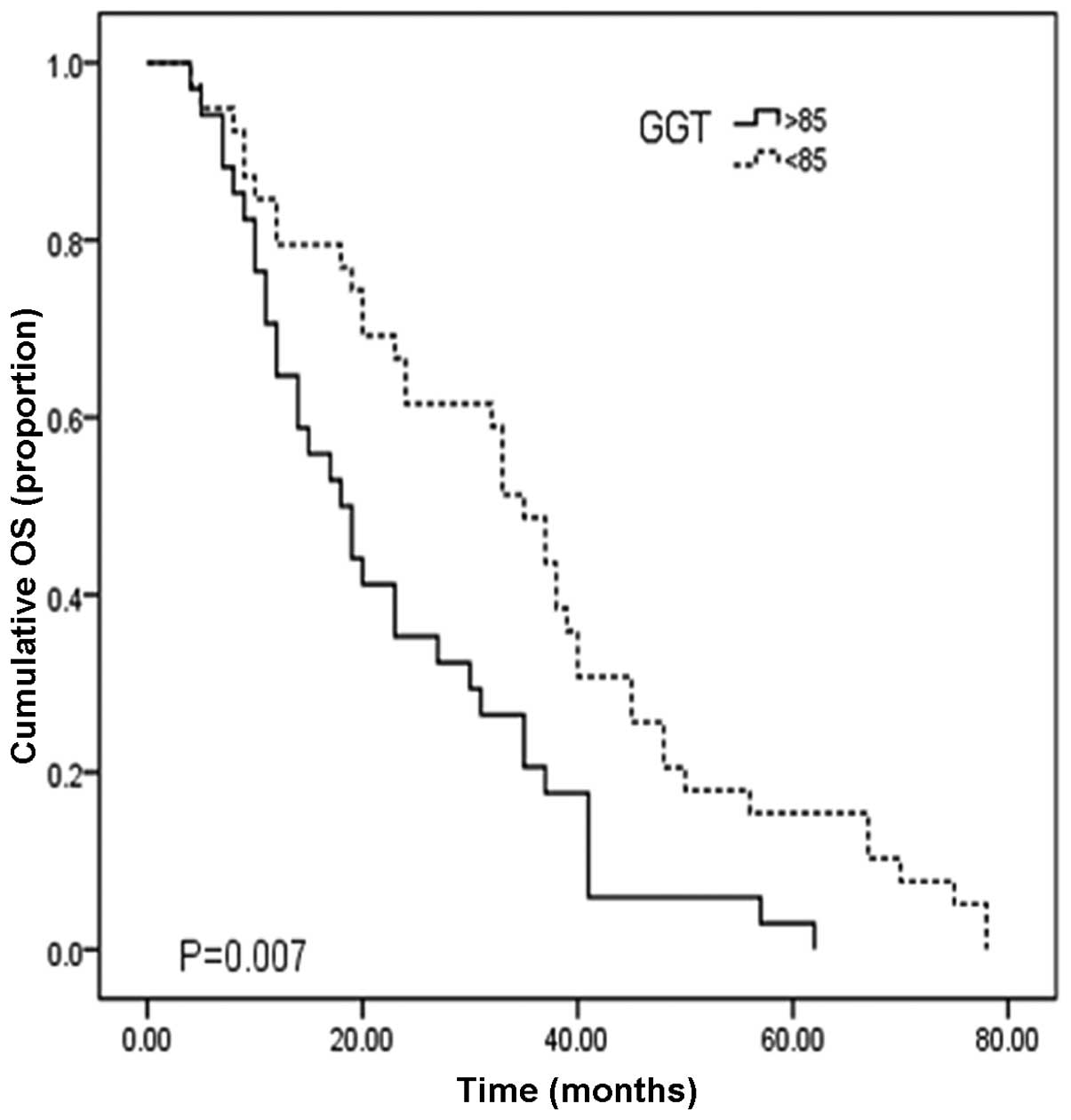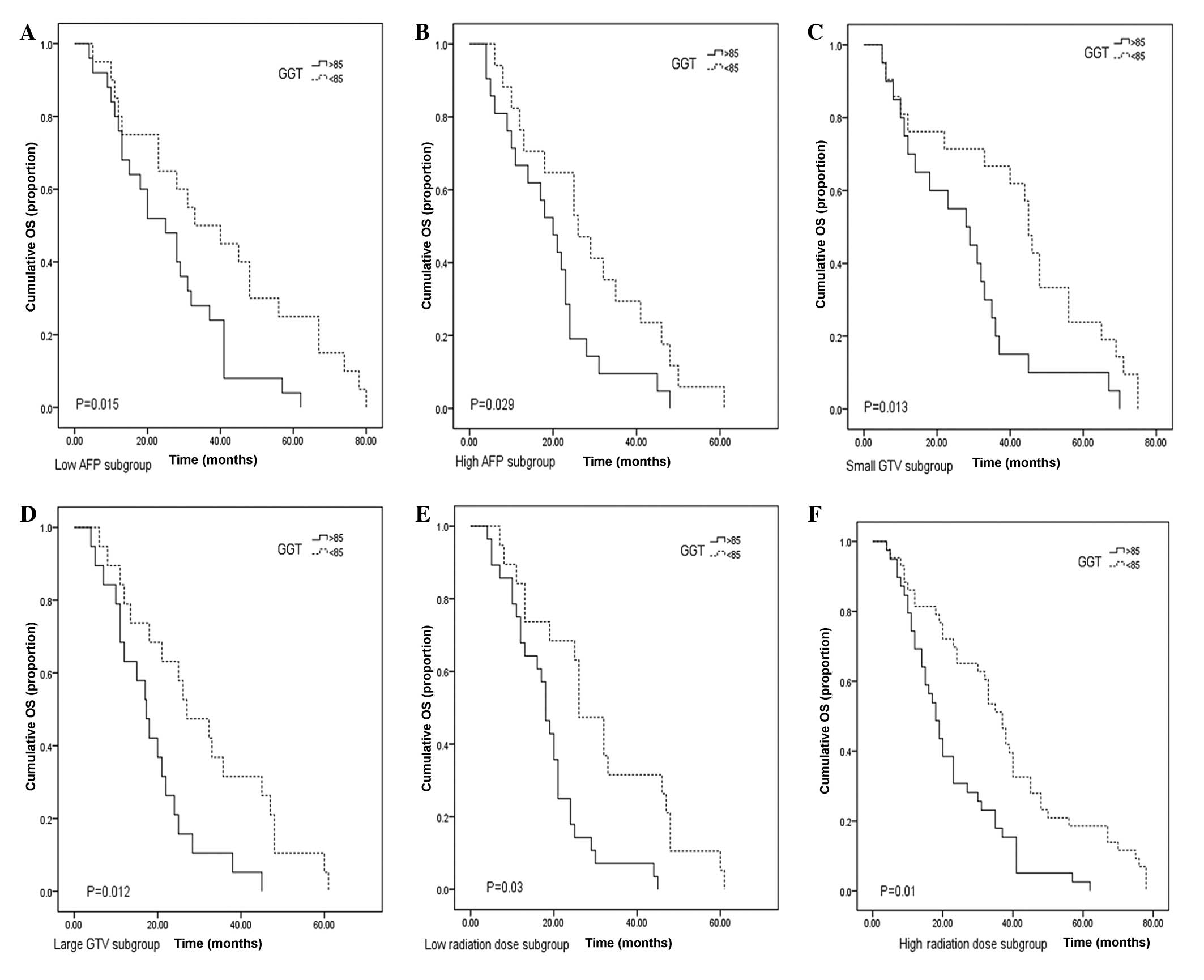|
1
|
Cárdenes HR: Role of stereotactic body
radiotherapy in the management of primary hepatocellular carcinoma.
Rationale, technique and results. Clin Transl Oncol. 11:276–283.
2009.
|
|
2
|
Nathan H, Schulick RD, Choti MA and Pawlik
TM: Predictors of survival after resection of early hepatocellular
carcinoma. Ann Surg. 249:799–805. 2009.
|
|
3
|
Cha CH, Saif MW, Yamane BH and Weber SM:
Hepatocellular carcinoma: current management. Curr Probl Surg.
47:10–67. 2010.
|
|
4
|
Zeng ZC, Tang ZY, Fan J, et al: A
comparison of chemoembolization combination with and without
radiotherapy for unresectable hepatocellular carcinoma. Cancer J.
10:307–316. 2004.
|
|
5
|
Xu LT, Zhou ZH, Lin JH, et al: Clinical
study of transarterial chemoembolization combined with
3-dimensional conformal radiotherapy for hepatocellular carcinoma.
Eur J Surg Oncol. 37:245–251. 2011.
|
|
6
|
Whitfield JB: Gamma glutamyl transferase.
Crit Rev Clin Lab Sci. 38:263–355. 2001.
|
|
7
|
Griffith OW, Bridges RJ and Meister A:
Transport of gamma-glutamyl amino acids: role of glutathione and
gamma-glutamyl transpeptidase. Proc Natl Acad Sci USA.
76:6319–6322. 1979.
|
|
8
|
Poynard T, Zourabichvili O, Hilpert G, et
al: Prognostic value of total serum bilirubin/gamma-glutamyl
transpeptidase ratio in cirrhotic patients. Hepatology. 4:324–327.
1984.
|
|
9
|
Ju MJ, Qiu SJ, Fan J, et al: Preoperative
serum gamma-glutamyl transferase to alanine aminotransferase ratio
is a convenient prognostic marker for Child-Pugh A hepatocellular
carcinoma after operation. J Gastroenterol. 44:635–642. 2009.
|
|
10
|
Zhang JB, Chen Y, Zhang B, et al:
Prognostic significance of serum gamma-glutamyl transferase in
patients with intermediate hepatocellular carcinoma treated with
transcatheter arterial chemoembolization. Eur J Gastroenterol
Hepatol. 23:787–793. 2011.
|
|
11
|
Llovet JM, Fuster J and Bruix J:
Barcelona-Clínic Liver Cancer Group: The Barcelona approach:
diagnosis, staging, and treatment of hepatocellular carcinoma.
Liver Transpl. 10:S115–S120. 2004.
|
|
12
|
Bruix J, Sherman M, Llovet JM, et al: EASL
Panel of Experts on HCC: Clinical management of hepatocellular
carcinoma. Conclusions of the Barcelona-2000 EASL Conference
European Association for the Study of the Liver. J Hepatol.
35:421–430. 2001.
|
|
13
|
Oken MM, Creech RH, Tormey DC, et al:
Toxicity and response criteria of the Eastern Cooperative Oncology
Group. Am J Clin Oncol. 5:649–655. 1982.
|
|
14
|
Saheb SM, Nath VN, Kumar KP and Padmaja
PP: A novel method using Seldinger’s technique for submental
intubation in major craniomaxillofacial fractures: A case series.
Indian J Anaesth. 58:48–50. 2014.
|
|
15
|
Kuo YC, Chiu YM, Shih WP, et al:
Volumetric intensity-modulated Arc (RapidArc) therapy for primary
hepatocellular carcinoma: comparison with intensity-modulated
radiotherapy and 3-D conformal radiotherapy. Radiat Oncol.
6:762011.
|
|
16
|
Whitfield JB, Pounder RE, Neale G and Moss
DW: Serum-glytamyl transpeptidase activity in liver disease. Gut.
13:702–708. 1972.
|
|
17
|
Idéo G, Morganti A and Dioguardi N:
Gamma-glutamyl transpeptidase: a clinical and experimental study.
Digestion. 5:326–336. 1972.
|
|
18
|
Hann HW, Wan S, Myers RE, et al:
Comprehensive analysis of common serum liver enzymes as prospective
predictors of hepatocellular carcinoma in HBV patients. PloS one.
7:e476872012.
|
|
19
|
Guiu B, Deschamps F, Boulin M, et al:
Serum gamma-glutamyl-transferase independently predicts outcome
after transarterial chemoembolization of hepatocellular carcinoma:
external validation. Cardiovasc Intervent Radiol. 35:1102–1108.
2012.
|
|
20
|
Hanigan MH: gamma-Glutamyl transpeptidase,
a glutathionase: its expression and function in carcinogenesis.
Chem Biol Interact. 111–112:333–342. 1998.
|
|
21
|
Pompella A, Corti A, Paolicchi A,
Giommarelli C and Zunino F: Gamma-glutamyltransferase, redox
regulation and cancer drug resistance. Curr Opin Pharmacol.
7:360–366. 2007.
|
|
22
|
Stark AA, Zeiger E and Pagano DA:
Glutathione metabolism by γ-glutamyl transpeptidase leads to lipid
peroxidation: characterization of the system and relevance to
hepatocarcinogenesis. Carcinogenesis. 14:183–189. 1993.
|
|
23
|
Paolicchi A, Tongiani R, Tonarelli P,
Comporti M and Pompella A: gamma-Glutamyl transpeptidase-dependent
lipid peroxidation in isolated hepatocytes and HepG2 hepatoma
cells. Free Radic Biol Med. 22:853–860. 1997.
|
|
24
|
Negre-Salvayre A, Auge N, Ayala V, et al:
Pathological aspects of lipid peroxidation. Free Radic Res.
44:1125–1171. 2010.
|
|
25
|
Zhao J, Zhao Y, Wang H, Gu X, Ji J and Gao
C: Association between metabolic abnormalities and HBV related
hepatocelluar carcinoma in Chinese: a cross-sectional study. Nutr
J. 10:492011.
|
|
26
|
Godwin AK, Meister A, O’Dwyer PJ, Huang
CS, Hamilton TC and Anderson ME: High resistance to cisplatin in
human ovarian cancer cell lines is associated with marked increase
of glutathione synthesis. Proc Natl Acad Sci USA. 89:3070–3074.
1992.
|
|
27
|
Daubeuf S, Balin D, Leroy P and Visvikis
A: Different mechanisms for gamma-glutamyltransferase-dependent
resistance to carboplatin and cisplatin. Biochem Pharmacol.
66:595–604. 2003.
|
|
28
|
Kouloulias V, Mosa E, Georgakopoulos J, et
al: Three-dimensional conformal radiotherapy for hepatocellular
carcinoma in patients unfit for resection, ablation, or
chemotherapy: A retrospective study. ScientificWorldJournal.
2013:7801412013.
|
|
29
|
Son SH, Choi BO, Ryu MR, et al:
Stereotactic body radiotherapy for patients with unresectable
primary hepatocellular carcinoma: dose-volumetric parameters
predicting the hepatic complication. Int J Radiat Oncol Biol Phys.
78:1073–1080. 2010.
|
|
30
|
Li M, Zhou S, Liu X, Li P, McNutt MA and
Li G: alpha-Fetoprotein shields hepatocellular carcinoma cells from
apoptosis induced by tumor necrosis factor-related
apoptosis-inducing ligand. Cancer Lett. 249:227–234. 2007.
|
|
31
|
Mitsuhashi N, Kobayashi S, Doki T, et al:
Clinical significance of alpha-fetoprotein: involvement in
proliferation, angiogenesis, and apoptosis of hepatocellular
carcinoma. J Gastroenterol Hepatol. 23:e189–e197. 2008.
|
|
32
|
Yang X, Zhang Y, Zhang L, Zhang L and Mao
J: Silencing alpha-fetoprotein expression induces growth arrest and
apoptosis in human hepatocellular cancer cell. Cancer Lett.
271:281–293. 2008.
|
|
33
|
Ho CM, Wu CY, Lee PH, Lai HS, Ho MC, Wu YM
and Hu RH: Analysis of the risk factors of untransplantable
recurrence after primary curative resection for patients with
hepatocellular carcinoma. Ann Surg Oncol. 20:2526–2533. 2013.
|
|
34
|
Siripongsakun S, Wei SH, Lin S, et al:
Evaluation of alpha-fetoprotein in detecting hepatocellular
carcinoma recurrence after radiofrequency ablation. J Gastroenterol
Hepatol. 29:157–164. 2014.
|
|
35
|
Tsai YJ, Hsu CY, Huang YH, et al: Early
identification of poor responders to transarterial
chemoembolization for hepatocellular carcinoma. Hepatol Int.
5:975–984. 2011.
|
|
36
|
Kohles N, Nagel D, Jüngst D, Durner J,
Stieber P and Holdenrieder S: Prognostic relevance of oncological
serum biomarkers in liver cancer patients undergoing transarterial
chemoembolization therapy. Tumor Biol. 33:33–40. 2012.
|













